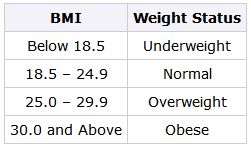CDC “Centers for Disease Control and Prevention” published an interesting article titled “About BMI for Adults”, here is an extract from the article:
What is BMI?
Body Mass Index (BMI) is a number calculated from a person’s weight and height. BMI provides a reliable indicator of body fatness for most people and is used to screen for weight categories that may lead to health problems.
BMI is used as a screening tool to identify possible weight problems for adults. However, BMI is not a diagnostic tool. For example, a person may have a high BMI. However, to determine if excess weight is a health risk, a healthcare provider would need to perform further assessments. These assessments might include skinfold thickness measurements, evaluations of diet, physical activity, family history, and other appropriate health screenings.
Calculating BMI is one of the best methods for population assessment of overweight and obesity. Because calculation requires only height and weight, it is inexpensive and easy to use for clinicians and for the general public. The use of BMI allows people to compare their own weight status to that of the general population.
How is BMI calculated and interpreted?
BMI is calculated the same way for both adults and children. The calculation is based on the following formulas:

Interpretation of BMI for adults
For adults 20 years old and older, BMI is interpreted using standard weight status categories that are the same for all ages and for both men and women. For children and teens, on the other hand, the interpretation of BMI is both age- and sex-specific. 
How reliable is BMI as an indicator of body fatness?
The correlation between the BMI number and body fatness is fairly strong; however the correlation varies by sex, race, and age. These variations include the following examples:
- At the same BMI, women tend to have more body fat than men.
- At the same BMI, older people, on average, tend to have more body fat than younger adults.
- Highly trained athletes may have a high BMI because of increased muscularity rather than increased body fatness.
It is also important to remember that BMI is only one factor related to risk for disease. For assessing someone’s likelihood of developing overweight- or obesity-related diseases, the National Heart, Lung, and Blood Institute guidelines recommend looking at two other predictors:
- The individual’s waist circumference (because abdominal fat is a predictor of risk for obesity-related diseases).
- Other risk factors the individual has for diseases and conditions associated with obesity (for example, high blood pressure or physical inactivity).
If an athlete or other person with a lot of muscle has a BMI over 25, is that person still considered to be overweight?
According to the BMI weight status categories, anyone with a BMI over 25 would be classified as overweight and anyone with a BMI over 30 would be classified as obese.
It is important to remember, however, that BMI is not a direct measure of body fatness and that BMI is calculated from an individual’s weight which includes both muscle and fat. As a result, some individuals may have a high BMI but not have a high percentage of body fat. For example, highly trained athletes may have a high BMI because of increased muscularity rather than increased body fatness. Although some people with a BMI in the overweight range (from 25.0 to 29.9) may not have excess body fatness, most people with a BMI in the obese range (equal to or greater than 30) will have increased levels of body fatness.
It is also important to remember that weight is only one factor related to risk for disease. If you have questions or concerns about the appropriateness of your weight, you should discuss them with your healthcare provider.
What are the health consequences of overweight and obesity for adults?
The BMI ranges are based on the relationship between body weight and disease and death.Overweight and obese individuals are at increased risk for many diseases and health conditions, including the following:
- Hypertension
- Dyslipidemia (for example, high LDL cholesterol, low HDL cholesterol, or high levels of triglycerides)
- Type 2 diabetes
- Coronary heart disease
- Stroke
- Gallbladder disease
- Osteoarthritis
- Sleep apnea and respiratory problems
- Some cancers (endometrial, breast, and colon)
Calculate your BMI
For more informations visit www.cdc.gov













Very descriptive article, I enjoyed that a lot. Will there be a part 2?
Just desire to say your article is as astonishing. The clearness in your post is simply cool and i could assume you’re an expert on this subject. Well with your permission allow me to grab your feed to keep updated with forthcoming post. Thanks a million and please keep up the gratifying work.
Hello first time to come to this forum, I like it very much!
This is a great post. Thanks so much for sharing, like always.
Thanks for such a great post and the review, I am totally impressed!
Thanks for the great Post very COOL!!!
I just want to mention I am just newbie to weblog and actually enjoyed your web site. More than likely I’m likely to bookmark your blog post . You amazingly have superb article content. Thanks a lot for sharing with us your web-site.
I simply want to say I am just newbie to blogging and honestly savored your web-site. Most likely I’m going to bookmark your site . You amazingly have good articles. Appreciate it for revealing your web-site.
I simply want to mention I’m very new to blogs and really enjoyed your page. Most likely I’m likely to bookmark your website . You amazingly come with beneficial posts. Thanks for sharing with us your website.
“I am not sure where you’re getting your info, but good topic. I needs to spend some time learning more or understanding more. Thanks for excellent info I was looking for this info for my mission.”